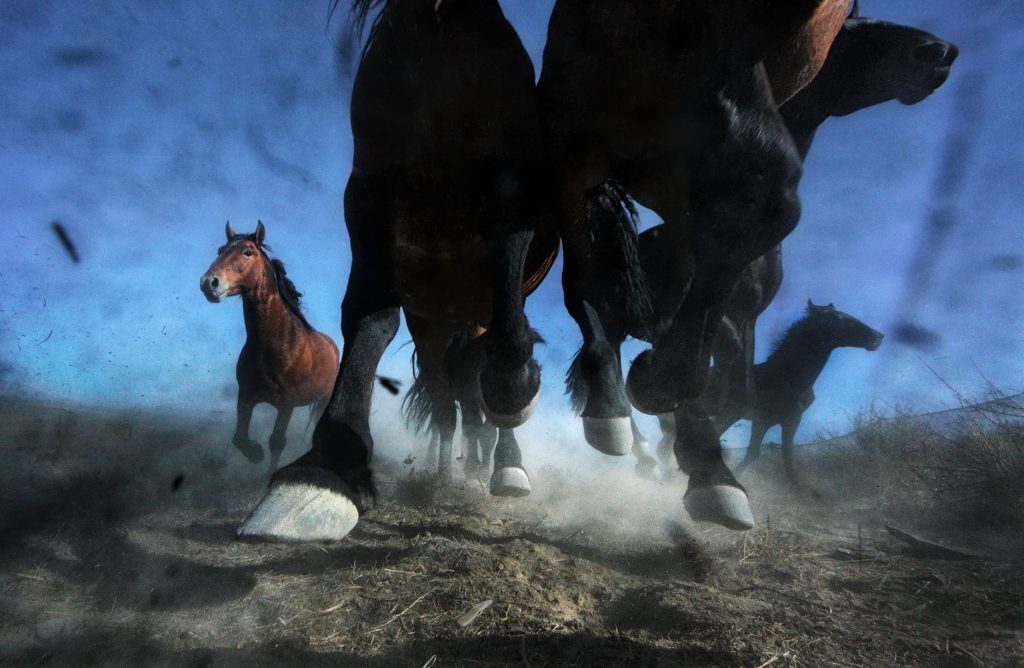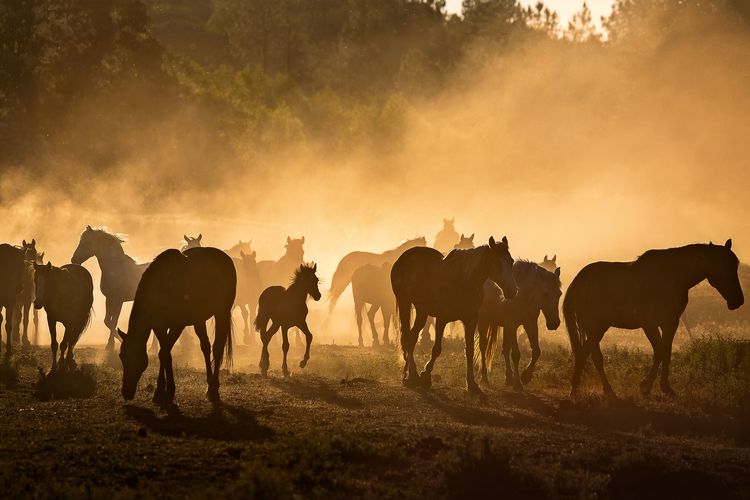CORRECTIONS WATCH
Fact-checking 13-year old photographic images in the Washington Post
The horses' photos tell one story — their captions tell another.

On December 1, 2020, I submitted a corrections request for errors in Britta Lokting’s November 18, 2020 magazine feature, The Wild Horse Wars, including nine photographs by Melissa Farlow from a 2009 National Geographic feature (Mustangs: Spirit of the Shrinking West).
Farlow’s photos are striking, but they’re not of wild horses on public lands today, as Lokting’s captions purport. Eight out of nine images are of captive horses and all of Farlow’s photos are old — 13 years, on average, according to her web site and National Geographic.

Cover 9//1/2007 
#2 9//1/2007 
#3 6/17/2007 
#4 5/21/08 
#5 5/2/2008 
#6 6/17/07 
#7 5/18/2008 
#8 6/2/2007 
#9 8/23/2007
Two photographs are from the same 2007 wild horse roundup; six others were photographed around the same time at two different horse sanctuaries.
Farlow’s cover image (captioned “Wild horses thunder across a desert in Nevada,” in the Washington Post) and photo 2 (“A herd in the Nevada desert.”) are from the same September 1, 2007 roundup in Jackson Mountains, Nevada, where 900 horses were stampeded by helicopters into a trap site.
One hundred horses died after being shipped to the Palomino Valley holding facility outside Reno, according to helicopter contractor Dave Cattoor. Those horses lost their freedom — some, their lives — a long time ago. None are running wild in the Nevada desert today. That’s a lie.
Five other photos (3,4,5,6 & 7) were taken at the International Society for the Protection of Mustangs and Burros (ISPMB) in South Dakota. The blue-eyed mare was photographed there on June 17, 2007 by Farlow, impounded along with 900+ other horses in 2016, relocated to an Oregon rescue and confirmed euthanized in early 2017 from a broken leg. Lokting’s photo caption in The Wild Horse Wars refers to her as: “A mare named Shoshone in South Dakota.”
Another ISPMB yearling photographed by Farlow on May 21, 2008 was still “A yearling with a shaggy, full winter coat in South Dakota” nearly 13 years later according to Lokting’s photo caption. Same deal with two IPSMB stallions, a horse standing in the moonlight and photo 8, which was taken at a horse rescue in Northern California. Lokting’s captions make them out to be wild free-roaming horses today. That’s false.
Below is an edited version of my second corrections email to the Washington Post, asking editors to fix the captions, or remove the images. Some of it repeats what you’ve just read and some of it is new. I hope you’ll read it.
December 29, 2020
Subject: Photography in The Wild Horse Wars
Dear Editors:
I spent several days fact-checking nine photos by Melissa Farlow in The Wild Horse Wars, all from a February 2009 National Geographic photo gallery on the photographer’s website. A Nat Geo representative confirmed that all nine photos were shot between June 2, 2007 and August 23, 2008, making them between 12 and 14 years old.
Photo captions in The Wild Horse Wars misrepresent the images as wild free-roaming horses on public lands today. That is false. The captions must be fixed or the images removed.
The cover photo and photo 2 were taken at a wild horse round-up on September 1, 2007, when 900 horses were stampeded into a trap, chased by helicopters. The Bureau of Land Management (BLM) then shipped them to a holding facility, where 100 of them died, according to Dave Cattoor of Cattoor Livestock Roundup.
Images 3, 4, 5, 6, 7 and 8 were photographed at two wild horse sanctuaries where a majority of the horses were bred and born. Photo 3 — the blue-eyed mare — was confirmed euthanized in early 2017. She died in Oregon, not in South Dakota.
Horses stampeded into traps and removed are not wild and free-roaming.
Horses at horse sanctuaries are not wild and free-roaming.
Dead horses are not wild and free-roaming.
They were not wild and free-roaming when those photos were taken.
They were not wild and free-roaming when “The Wild Horse Wars” was published on November 18, 2020.
It’s hard to understand why the Washington Post would buy outdated images from National Geographic — then strip away their truths and replace them with misinformation.
Cover photo and photo 2 captions replace an absolute truth (that the horses are running for their lives while being chased by a helicopter) with a fiction (the horses are thundering across sensitive desert ecosystems just because). That fiction pushes Washington Post readers toward agreement with the drastic solutions that The Wild Horse Wars advocates (round-ups, ovariectomies, slaughter) when they would otherwise express opposition.
There are other copyediting errors that need fixing.
The Washington Post has a duty to report the truth (“Democracy Dies in Darkness”). It doesn’t allow the truth to be bent just because the subjects are voiceless animals. The captivating photos and their new captions may pull readers in, but they’re good-looking fakes.
The Post’s website invites corrections from readers. I’m a fact-checker and journalist on wild horse politics and public lands policies. I submitted a request on December 1, 2020 for The Wild Horse Wars, flagging nine different errors, including the age of nine photos. I emailed it to the features editor (name removed), the writer (Ms. Lokting) and the corrections email address, along with data and documentation from the BLM website (Lokting’s primary source) and other government sources.
A Star Tribune News research staffer notified me that my request had been passed on to editors the day I sent it. No one has responded. What happened to it?
The Washington Post’s wild-horse reporting has been error-filled for years. The corrections requests and documentation I’ve submitted during that time would fix the most egregious errors, but no one responds and errors continue to be made.
Who is fact-checking reporters? Are the invitations to submit corrections genuine? Does the Washington Post care about reader input as its website proclaims? About shining a light on the darkness of disinformation?
I look forward to a response to my December 1, 2020 submission (also attached) and this present request.
Thank you.
Sincerely,
Vickery Eckhoff
New York, NY
NOTE: the editor of the Washington Post Magazine contacted me on January 4th with a truly insignificant cosmetic fix. He avoided discussion of the other errors. I responded with a letter on January 6. It remains unanswered and for that, I give the Washington Post four Pinocchios.
Please leave a comment below, follow me @viglet on twitter and read other Daily Pitchfork posts pushing mainstream news outlets to correct their errors:
Fact-checking 9 errors in the Washington Post, Seattle Times and Houston Chronicle (12/12/20)
Fact-checking errors and omissions in the New York Time (12/12/20)
Fact-checking The New York Times: Sources claim wild horse damage, but photos show cattle did it. (12/12/20)
Fact-checking the New York Times: Maps and data expose cattle, not wild horses, as looming crisis. (12/15/20)

Now I am wondering what the rest of WaPo’s reporting on other stories is really like. They sound like Fox News.
When demonstrable lies are accorded the implicit ‘respect’ of being reported neutrally, “truth” is dead.
RIP.
It is time to tell the truth about our public lands and the wild horses and burros who live there. We have 5 of ISPMB horses at our rescue. They were part of 900 mustangs rescued from South Dakota ISPMB due to extreme neglect many years ago. Pretending that these horses still run free is simply not true. Failing to dig deeper into opposing views makes what you wrote extremely skewed to a pro-ranching and mineral extracting point of view. Look deeper, and you will discover how much of your article is factually completely wrong.
Thank you doesn’t seem to be enough. The truth about our wild horses and the land they call home needs to be told. You have spoken loud and clear. No more can we allow the untruths.
The wild ones deserve better and you have provided that for them. Thank you once again
Thank you for exposing the shoddy treatment of this important issue by the Washington Post.
So Very SAD the truth is hidden !
The Washington Post Should be held
Accountable and Libel for miss Representation of THE TRUTH
THE PHOTIS ARE OUT DATED AND MISS REPRESENTATED. SHAME ON YOU W.P.
Where to start…
Among the items in the article that illustrate how shallow that information pool is is this:
The oft-repeated anecdote about wild horses keeping other animals away from water.
Long ago, during a field study, a USGS agent saw a horse chase a Big Horn away from a pond.
It has now become like a Biblical reference. I’ve written comments to at least five EAs for wild horse removals that use this single incident to vilify the horses as greedy despots taking more than their fair share.
What no one who writes this drivel ever includes is that smaller animals tend to group themselves with horses for safety from predators. And in the dead of Winter, when shallow water sources are often frozen over with thick ice, the horses are the only animals heavy enough to break the crust – so everyone can drink.
A personal bete noir: the lack of visual documentation of the herds during flyovers. No photos. No video. Just massive populations, ‘estimated’ and quoted as unverified fact.
So much of that article was itself unverified, just tired, recycled rhetoric also so oft-repeated no one thinks about whether it could be fiction or fact.
Thank you, Vickery, for not allowing that version of ‘the truth’ to waddle by without kicking it.
So many untruths on our Wild Horses and they do deserve better! Much better.our Gov should manage their welfare much better! Such Magnificent Creature of our Land..Speak the Truth Thank You.
If this article can’t start with reputable images, how can they possibly think we would believe what is in print? Why is there no accountability for either? As a news source, they should be held to a higher standard if anything. I hope they start with the images, and then work their way through the article. making corrections.
Vickery’s work is always solid and spot on. News organizations have been stripped down to skeleton crews who work off of news releases and who have no time to fact check information being fed to them by the BLM, which notoriously over counts the numbers of horses on the range to justify higher budgets for roundups. I have been following her work for years and urge anyone else who wants the straight story on our wild horses to follow her coverage.
Publishing false or outdated information about this issue isn’t helping our iconic wild horses and burros!!! Report the facts, correct your lies and maintain your journalistic integrity or you simply remain part of the problem and not the part of the solution!